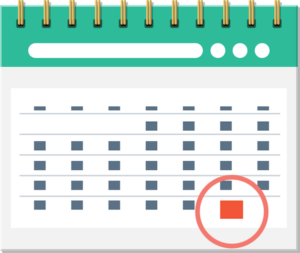
It’s very common that we get questions about project completion dates and its effect on a party’s mechanics lien or bond claim rights. This is an important and tricky topic, and unfortunately, there aren’t very many answers. In fact, I spent 6 months digging into California county records to locate a solution to the “completion date problem,” to no avail and scorned the legislature for not including better handling of this common problem when they rewrote the rest of the mechanics lien laws a few years ago. (See: 1 Thing California’s New Mechanics Lien Law Should Include, But Doesn’t).
The completion date problem, however, is not solely a California problem. As I’ll explain in this post the problem is fairly widespread and it leaves subcontractors and (especially) suppliers in the dark about when their mechanics lien or bond claim rights may expire. This article will explain the problem and when it applies and will propose some available solutions for your business.
When the project completion date matters for your mechanics lien or bond claim rights

We can separate lien and bond claim deadlines into two categories: “driven by completion date” or “driven by individual furnishing.” Or put in another way, substantial completion vs. date of last furnishing.
Driven by completion date
Mechanics lien or bond claim deadlines “driven by completion” establish a time frame for filing a claim that is based on when the entire construction project has reached substantial completion or actual completion. This scenario is quite rare on private projects with only 5 or 6 states calculating its deadlines in this way. Most famously, California’s lien deadlines start counting from the project’s completion.
The “driven by completion” type deadlines are far more common on government projects, but it is still a minority rule across the country. Nevertheless, if your deadline is driven by completion pursuant to the state’s requirements, knowing the entire project’s substantial completion or final completion date is very important.
Driven by individual furnishing
Mechanics lien or bond claim deadlines “driven by individual furnishing” establishes a time frame for filing a claim that is based on when the claimant individually last furnished to the project or reached contract completion. This scenario is far more common, as in most states the start date for the deadline clock is the last date of furnishing labor or materials to the project. This can be particularly challenging for general contractors to calculate.
When a deadline is driven by individual furnishing, the entire project’s substantial or final completion date is irrelevant to your deadlines. It’s based solely on the last date the claimant was onsite providing labor, materials, or services to the improvement.
How do you know the project completion date?
You need only care about a project’s completion date when furnishing to a project with a lien or bond claim deadline “driven by completion.” Unfortunately, when such is the case, you’ll likely be without much information or many options.
The general contractors and project management teams will know when the project is completed because they’ll be there. This is not the case with subcontractors and material suppliers. These parties come in and provide a specific furnishing to the project, and then leave. In the case of material suppliers, they may even be thousands of miles away and shipping to the job site.
Notice of Completion filing
Each state’s laws are different with respect to how “completion” is determined, but almost every state lacks any useful mechanism for advertising the completion date to the public or project participants. Some states “require” a “Notice of Completion” be filed in public records, but this is pretty useless to project participants because: (i) It’s very frequently not filed; and (ii) It’s not really that “public” as you’ll need to send a courier to the county to check and see if it’s been filed over and over again.
Requesting the completion date
There are a very tiny number of states that at least allow you to request project information and to be notified about the completion date. Louisiana, for example, has a “Notice to Owner of Obligations” document that creates a duty for the owner to notify you of the project’s completion date. California allows you to file your preliminary notice with the recorder to create a duty on the recorder to notify you of any completion filing. But – surprise, surprise – it’s very inconsistently adhered to and there are little to no consequences if the obligated party fails to perform.
The heading to this section asks a common question: How do you know or obtain a project’s completion date? The answer is simply that you don’t.
Sure, you can go to the county recorder’s office and search to see if a notice has been filed. In reality, however, your workload of projects and the speed of business makes this a non-starter.
What is “completion” anyways?
Another wrinkle to this question is the completion concept itself and specifically what qualifies a project as “complete.” This question grows more complicated because state laws distinguish between “substantial completion” and “final completion,” and your mechanics lien or bond claim deadlines may be driven by one or the other.
If you’re in the construction business you know that “completion” of work is an elusive concept. The industry has dissected the word “completion” and created substantial completion, final completion, completion subject to punch list items, completion that marks the start of a warranty period, and on and on.
The short answer to “what is completion anyway” throws you back into this torpedo of definitions. Each state and circumstance is different as to which “completion” actually matters when trying to calculate a mechanics lien or bond claim deadline, and it is sometimes made more complicated by allowing general contractors or project managers to file a “notice of completion” and set their own (sometimes incorrect) milestone date.
What to do to protect lien and bond claim rights in the face of this project completion date nightmare?
Bottom line: Do not wait for, track, or be too terribly concerned about when the project is completed. It’s only going to give you headaches and throw your right to file a lien into a murky legal gray area. You want to stay in control of your lien rights, and therefore, do exactly that.
1. Know the nature of your work and where it falls on the project schedule
Do you normally leave a job towards the beginning or end of a project? Where does your project activity fall on the critical path schedule? If you’re in the business of doing site foundation work there will likely be a pretty healthy amount of time between when you stop work and the completion of the entire project. If you’re a finish contractor, however, the end of the project will be pretty soon after your furnishing. Understand this about your work and use that to frame your approach to the deadline.
2. Calculate your “completely safe lien period” and track it
When a state has a “driven by completion” deadline, the Levelset platform calculates the deadline by counting the appropriate number of days from the completion date or your last furnishing date, whichever is later. Therefore, when you don’t know the completion date and only know your last furnishing date, the system will calculate your deadline based on the last furnishing date only. This creates a ‘safe lien period.’
You’ll probably have more time to file your lien because the project likely continued after your work, but taking the lien period and driving it by your last furnishing gives you a deadline that will be pretty safe to follow. If you file within that period, you’ll almost always be on time.
3. Use common sense to decide when to file your claim
You’ll probably have some extra time after your “safe period” expires, but then again, if your safe period expires why is the debt still unpaid? The safe period is likely to be long enough to throw your account into default. It’s okay to tread water for a little while waiting for payment, but the longer you go without filing your lien claim, the closer the true lien period’s end will be.

